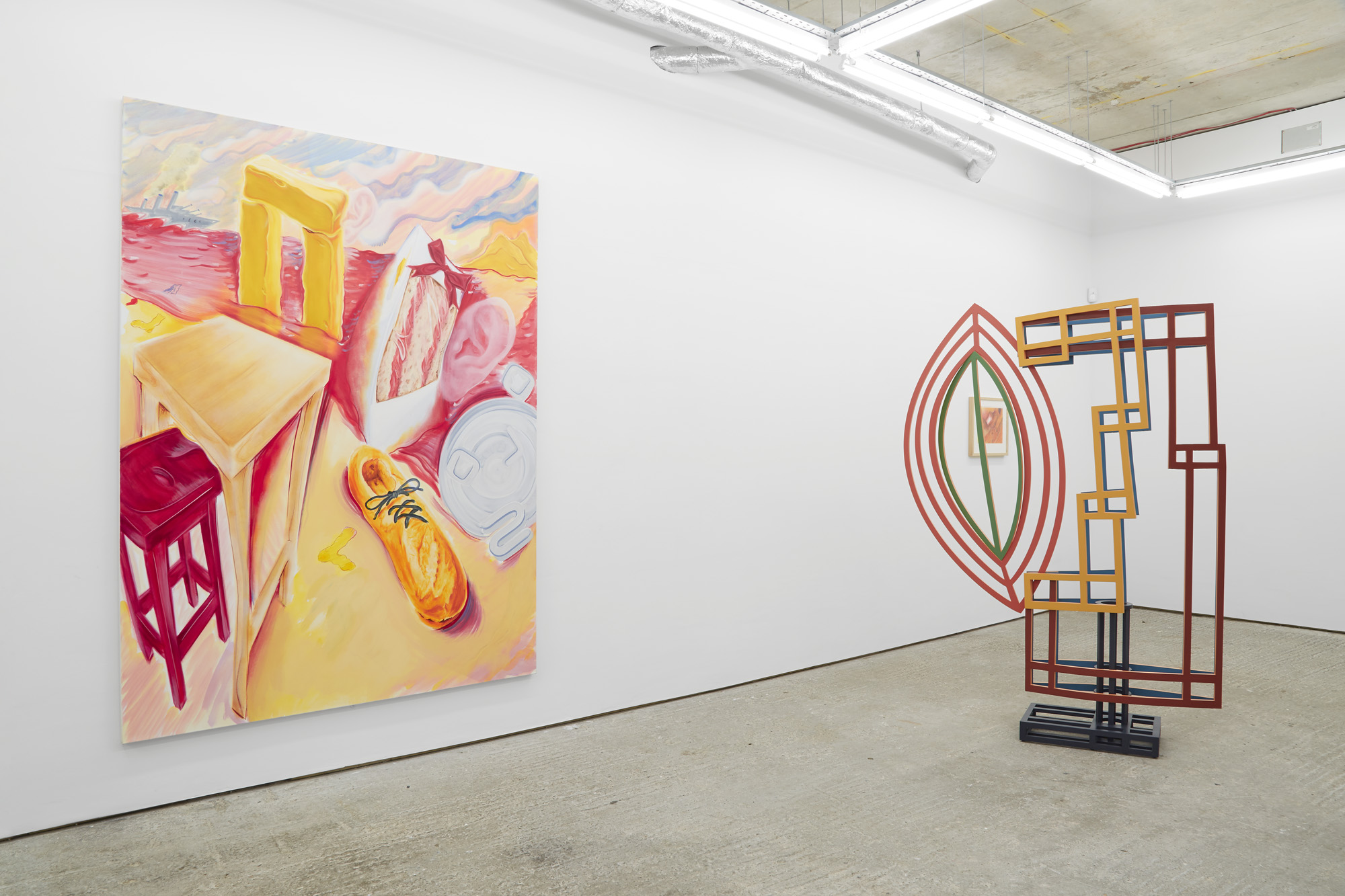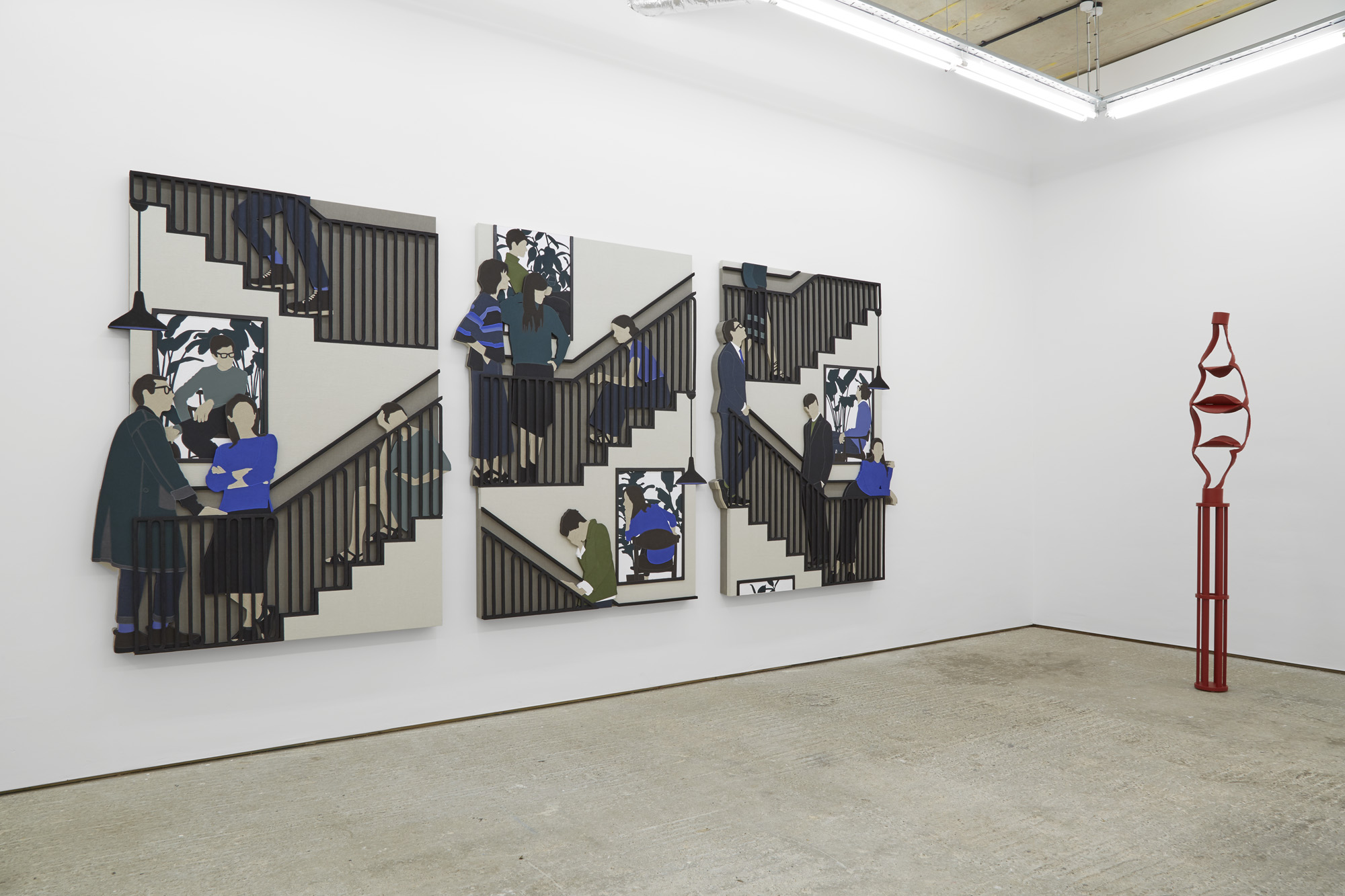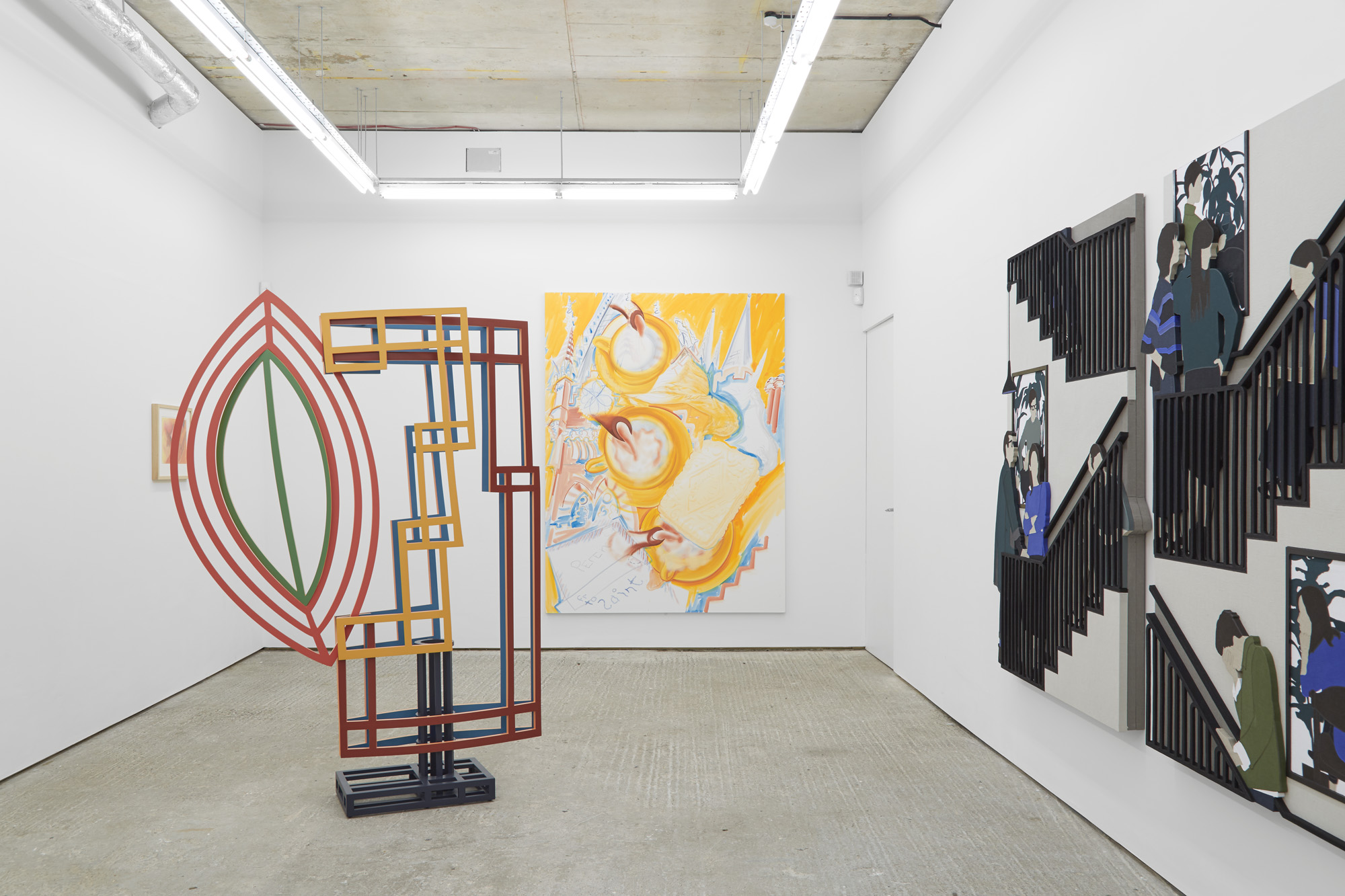“The physical and the visual, the tactile and intangible seem to be important considerations for all three of us.” Lauren Keeley is currently showing alongside Nicholas Hatfull and Jackson Sprague in Parallax Scrolling, a lively exploration of “the illusion of movement and depth within a constructed reality.”
Hatfull, Keeley and Sprague create incredibly varied works, yet they all have a practice which feels precise and highly considerate of space and dimension, while each exhibiting a high level of craftsmanship. Walking into Breese Little’s clean white east London space, framed elegantly by a rectangular neon white light on the ceiling, viewers are greeted with a vibrant pulsing of colour. This is thanks, in no small part, to a luminous pink and yellow painting by Hatfull, Paysan (la logica del wackaging), which sits to the left of the entrance. While the piece contains many elements which are characteristic of Hatfull’s work—fluid forms floating in a manner which defies the two-dimensional space they inhabit, edibles merging into boots and furniture and brush strokes borrowed from a wide-range of sources including political cartoonists and watercolour painting—it feels like one of his wildest to date.
“Pret A Manger iconography and Martin Rowson’s scalding wildernesses were touchstones for this painting,” he says, “which sees a smoked salmon sandwich carton and baguette shoe emerging on the shore. I deal in hopelessly mixed metaphors, disoriented lyrics, retooling my motifs and dispatching them with all the brio I can muster, in the hope they give off steam inside the painting.”
After a long-running interest in Pret A Manger, the artist has recently found inspiration in the Yorkshire tea brand Taylors of Harrogate. His second painting, The scent of rushes (Hector of Harrogate), crammed with teapot spouts pouring cups of tea and floating custard creams, explores this. The piece is “an associative improvisation drawing on a Taylors of Harrogate TV advert, Raymond Briggs animations and the facade of the St. Pancras Hotel. Almost evaporating off the surface are images of a sowers hat and a custard cream biscuit—I was taken with the custard cream both because of the metaphysical heritage of biscuits in painting (viz. De Chirico) and remembering they were an endangered species for a time in 2016 when their factory was flooded.”
An everyday scene becomes the point of focus for a work of high design in Keeley’s three-panelled piece which hangs on the perpendicular wall. A staircase is inhabited by individuals who are at once blank and characterised, missing key facial features yet displaying a range of emotions and social statuses through their stances, groupings and choice of clothing. Some sit pensively alone on the stairs, others are grouped in conversation, sometimes engrossed, sometimes staring toward another group. Their complimentary outfits, taken from a narrow palette of blues and greens, call to mind a social group from within an advertising campaign, a corporate vision of domesticity.
Despite the cleanness of this piece, it is a highly intricate work in both its design and construction. The three panels hung horizontally do, in fact, fit together vertically—a point which becomes clear the longer you view. “In the past, I have made images that are continuations of each other horizontally,” Keeley says, “so for the show, I took the motif of the staircase and used it to organise the imagery in a vertical series. Of course, in the gallery, they are displayed back as a horizontal group, but I really liked this reformation. The scene becomes disturbed and the cropping of each panel more severe to disrupt the viewer’s gaze somewhat.”
“The title Parallax Scrolling was chosen by Rebecca Lewin [whose short film screening programme preceded the show] after lots of discussions with the group and seemed to fit everyone’s work in really interesting but slightly different ways. The form of my work linked really nicely with the title, the fact that I place physical space between flat layers to give the impression of depth and distance is not so dissimilar to this type of computer graphic technique. However, having left the flatness of the screen, the resulting works are as much physical as they are visual, they are both object and image, forming reliefs on the gallery wall. The physical and the visual, the tactile and intangible seem to be important considerations for all three of us, and one thing that we spoke a lot about before the show was the difference between working physically in the studio and working digitally to prepare work for fabrication. For me, there’s a real interest in a studio practice and the craft of the hand, it forms a huge part of the work.”
To form the work, pieces are cut individually then covered in fabric by hand and the joins of each surface are finished with a mix of Polyfilla and acrylic. The final appearance, in line with the conflict of coldness and emotion within the scene, is almost so clean that the hand of the artist feels impossible. “There’s an engagement with the counteraction—the craft of software and the intangible precision of the computer,” Keeley says. “The work is almost entirely manually made once in physical form and the linens and hardwoods that are used across the surfaces give it a very materially tactile presence. But despite this, the foundation of the work will always be in the digital, and I think the flatness and coolness of the screen visually remains.”
Sprague’s works play on a similar border between tactility and formal perfection. His My Hand On Your Eye–which in itself suggests an intimate level of physical closeness—is entirely hand crafted and precisely painted, the planes of its wooden form meeting in a sharp line, one colour to the next. From its thinner side, all of its planes are painted in a fleshy peach, bringing this man-made shape back, once again, to the human body.
Despite their stillness, his pieces both also hint at the possibility of movement, their parts looking as though they’re about to spring into mobile-like action, spinning and twisting. “I’m both captivated and frustrated by objects that emit a kind of resolute stillness,” he says, “and I’ve often concentrated on ways to activate my own sculptural work and the space around it. With the sculptures in Parallax Scrolling I’ve focused on the body as a space for that activity; the close proximity of my own body in those intimate moments of production in the studio and how that might be carried over and reflected in the gallery where the viewer is mobilised, physically and psychologically, as they circle and survey the works. These works are very much still points, compositional and psychical moments held in place, mobilising the space around them.”
‘Parallax Scrolling‘ is showing at Breese Little, London until 18 March. All images: Installation view, Parallax Scrolling: Nicholas Hatfull, Lauren Keeley and Jackson Sprague. Courtesy the artists and Breese Little, London









